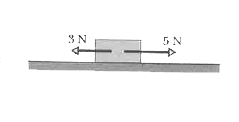Complete Solutions to CHECKPOINT of chapter FORCE AND MOTION - I of Class 12 book with complete answers and questions
| Class 12 | PHYSICS |
| Chapter | FORCE AND MOTION - I |
| RESNICK AND HALLIDAY | CHECKPOINT |
| Number Of Questions | 5 |
| Academic Year | 2023-24 |
Which of the figure's six arrangements correctly show the vector addition of forces `vec(F)_(1)` and `vec(F)_(2)` to yield the third vector, which is meant to represent their net force `vec(F)_("net")` ?

View SolutionThe figure here shows two horizontal forces acting on a block on a frictionless floor. If a third horizontal force `vec(F)_(3)` also acts on the block, what are the magnitude and direction of `vec(F)_(3)` when the block is (a) stationary and (b) moving to the left with a constant speed of `5" m"//"s"` ?

View SolutionSuppose that the cantaloupe and table of Fig. 5-6 are in an elevator cab that begins to accelerate upward. (a) Do the magnitudes of `vec(F)_(TC)` and `vec(F)_(CT)` increase, decrease, or stay the same ? (b) Are those two forces still equal in magnitude and opposite in direction? ( c ) Do the magnitudes of `vec(F)_(CE)` and `vec(F)_(EC)` increase, decrease, or stay the same? (d) Are those two forces still equal in magnitude and opposite in direction?
View SolutionIn Fig. 5-9, is the magnitude of the normal force `vec(F)_(N)` greater than, less than, or equal to mg if the block and table are in an elevator moving upward (a) at constant speed and (b) at increasing speed?
View SolutionThe suspended body having weighs 75 N. Is T equal to, greater than, or less than 75 N when the body (a) at constant speed, (b) at increasing speed, and ( c ) at decreasing speed?
View Solution
CHECKPOINT questions and complete solutions for chapter FORCE AND MOTION - I of RESNICK AND HALLIDAY PHYSICS (HINGLISH) of Class 12